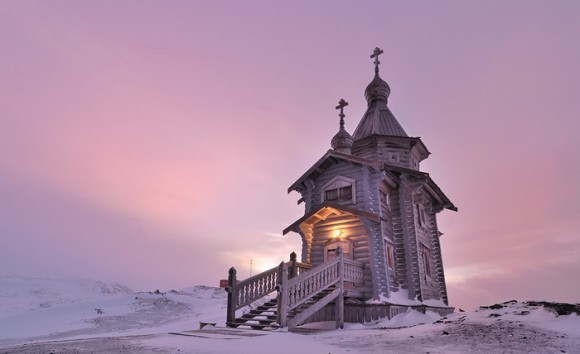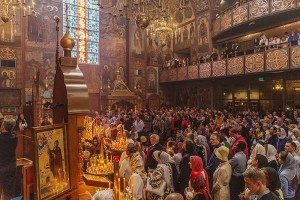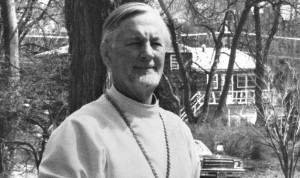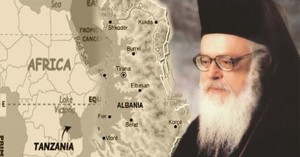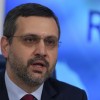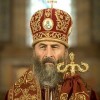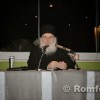We often complain about life: Public transport is really annoying… Where are all these people going anyway?… We’ve had enough of this rain… Why is this heat so unbearable?… What do they want me to do anyway? I’m fed up with all this shouting and noise and fuss… We could go on listing the complaints, dreaming about being on our own and how nice it is everywhere else, and in general having a moan and making out we want to get away from it all. But once you are at the end of the earth, suddenly everything is the other way around and you look at the world in a completely new way.
 These are the thoughts I had when I met Hieromonk Pavel (Gelyastanov) who had just come back from an obedience of 15 months in the Antarctic. I don’t know if it is correct to call the Antarctic the end of the earth, but it could probably be called the end of the planet or the end of the map. Though, on the other hand, you can’t really see any earth in the Antarctic, rather it’s all ice, snow, water and rocks and Polar birdlife. But on top of this you have the people who are always there, far fewer than the visitors, but they live there in the kingdom of snow for about a year on average: they come from various countries to carry out some special task and then go home. This is why the Antarctic, discovered in 1820 by the Russian explorers Bellingshausen and Lazarev, is called a free country: there are no politics, no economy, no citizenship, no social divisions…
These are the thoughts I had when I met Hieromonk Pavel (Gelyastanov) who had just come back from an obedience of 15 months in the Antarctic. I don’t know if it is correct to call the Antarctic the end of the earth, but it could probably be called the end of the planet or the end of the map. Though, on the other hand, you can’t really see any earth in the Antarctic, rather it’s all ice, snow, water and rocks and Polar birdlife. But on top of this you have the people who are always there, far fewer than the visitors, but they live there in the kingdom of snow for about a year on average: they come from various countries to carry out some special task and then go home. This is why the Antarctic, discovered in 1820 by the Russian explorers Bellingshausen and Lazarev, is called a free country: there are no politics, no economy, no citizenship, no social divisions…
How did Fr Paul, a monk from the Novospassky Monastery in Moscow, end up there? I tried to find the answer to this question not among the ice, but in Minsk, in our monastery where Father had come to ‘thaw out’ after his very long winter stay.
Tell us, Fr Paul, how come you went to the Antarctic?
At the request of Archbishop Theognost, the Superior of the Holy Trinity-St Sergius Monastery, a decree was issued by his Holiness the Patriarch that I should be sent as a member of the 56th Russian Antarctic Expedition. I arrived there on 3 March 2011 to serve in the Holy Trinity church in Bellingshausen.
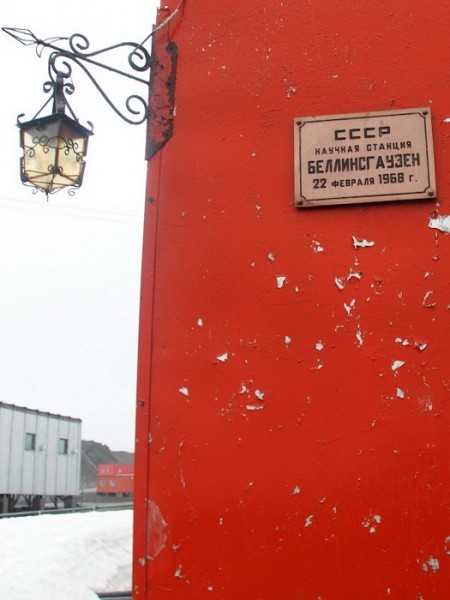 This is the only church in the southern continent and, it must be said, as such it is not only the object of curiosity, but also of respect. Anyone who goes to our island first of all goes to church, has their photo taken, asks about the history of the church and many come and venerate the icons. It’s a local sight.
This is the only church in the southern continent and, it must be said, as such it is not only the object of curiosity, but also of respect. Anyone who goes to our island first of all goes to church, has their photo taken, asks about the history of the church and many come and venerate the icons. It’s a local sight.
When we flew in, the first thing we did was to hold a thanksgiving service. We were met by good weather. True, there were some heavy gusts of wind, but they did not stop us from admiring the wonderful views on the descent. Out station is situated on King George Island; next door to us are the scientific stations of Chile, Argentina, Uruguay, Brazil, Korea, China and Poland. Our station and the landing strip of the Chilean base ‘Via Frey’ are on the part of the land which is ice free in the summer.
Places like this are called oasis – they cover less than 5% of the island. Of course, the nature is amazing! Actually, penguins are very similar to monks. They have a little white cassock on their fronts and they are dressed, so to speak, in a little black overcassock on top. They are very good-natured, they walk on their legs like human-beings, and they are inquisitive and not afraid of people.
Who was priest in the Holy Trinity church before you?
Hieromonk Sophrony and Hierodeacon Pallady, also monks of the Holy Trinity-St Sergius Monastery), spent over fourteen months there as part of the 55th Expedition. The whole concept of setting up a permanent church at the South Pole was the idea of the head of the Russian Antarctic Expedition, Valery Lukin, and His Holiness Patriarch Alexis II. This was backed by Peter Zadirov who was then the head of a company called Anteks-Polyus.
A trust fund called ‘A Church in the Antarctic’ was set up and a nationwide competition for designs was held. Church builders from Barnaul won it. The site of the church was blessed on 20 January 2002 and the church was built on 15 February 2004. The superior of Holy Trinity-St Sergius Monastery, Bishop Theognost of Sergievo-Posad consecrated it together with a whole group of clergy, pilgrims and benefactors who came on a special flight from the nearest Chilean town of Punta-Arenas.
The first rector of the church was Hieromonk Kallistrat (Romanenko), he was followed by Hieromonk Gabriel (Bogachikhin) and his assistant Vladimir Petrakov. Almost all the clergy who had the obedience of pastoral care for the polar workers were monks from Holy Trinity- St Sergius Monastery and changed over every year, more or less like those who worked at the Antarctic polar stations themselves.
What did you do on the first days of your stay in the Antarctic?
A parishioner of our Monastery, Anatoly Pristupa, received a blessing and was given the obedience together with me. He served in the altar, sang, read, baked prosphora, rang the bells and also worked as a restorer…Our first task was to set up the new two-tier iconostasis together with Hieromonk Gabriel (Bogachikhin) and the artist and restorer Valery Grishanov, who had painted the icons. These had been painted especially for conditions in the Antarctic. On 6 March 2011 we invited all seventeen members of the Expedition with their head, Bulat Rafaelovich Mavlyudov, to the church, where we did the little blessing of water, blessed the icons and the iconostasis, the people and read the prayers for the Increase of Love and for Those Who Travel, and took a photograph of everyone together. After this Fr Gabriel and Valery flew back to Moscow.
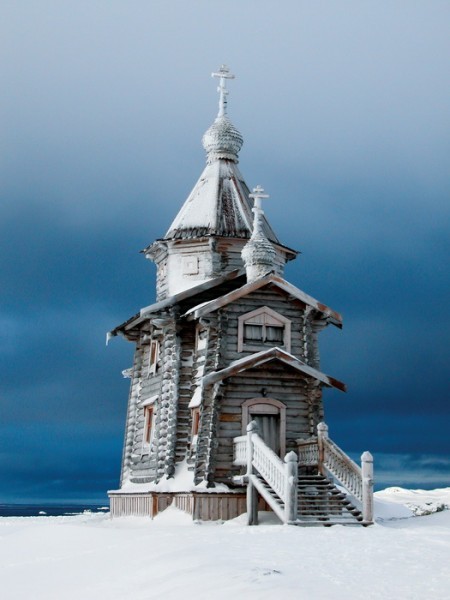
The church is built of logs in the Old Russian style with a belfry. There are eight chains from the foundation to the dome which help to protect it from the wind. The thick logs and the chains too, which are painted a bronze colour and go up somewhere past the ceiling, give it a fairy-tale feel and you cannot help remembering Pushkin’s verses, ‘There is a green oak by a curved bay, and on that oak a golden chain…’. Once in the winter we had a very unusual and mysterious night time service.
The words of the prayers and the sound of the bells with the winds and the creaking of the frozen logs gave you the impression, if you closed your eyes, of being in an old sailing ship crossing a stormy sea. Given those circumstances, the irmos of the sixth ode of the canon to our Lord Jesus Christ sounded quite different: ‘Beholding the sea of life surging high with the storm of temptations, I have fled to Thy calm haven and cry aloud to Thee; lead my life forth from corruption, O Most Merciful One’.
Who are these people who live at the South Pole?
They come from various countries but are very friendly, they invite each other over and selflessly help each other. The way life is organized there is reminiscent of life on Mt Athos, at least according to the stories that are told. If Athos is a monastic republic, then the Antarctic could be called a polar republic. The precise way work is organized is much the same, the voluntary submission to a strict code of discipline (for instance, if you do not have permission from the head, you cannot leave the station; you must absolutely sign a register, saying where and how long you will be away for; give the estimated time of your return; take rations with you).
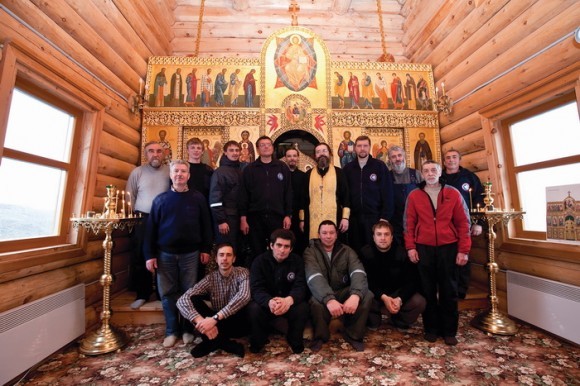 Each station is a sort of monastery with its own rules, its abbot and monks, property and territory. No door on any dwelling or station anywhere on the island is ever locked. Nobody would ever steal anything. Every dwelling has food inside and anyone who has been caught out by bad weather can shelter inside at any time. I remember on the third Sunday of Lent we served the Liturgy of St Basil the Great. After the service we left, but when we came back in the evening we found flowers on the stand! And they were so bright! It was really nice, especially when there’s not a tree or a blade of grass or a leaf in sight! Who put them there is a mystery. Thank you and may the Lord save him (or them)…
Each station is a sort of monastery with its own rules, its abbot and monks, property and territory. No door on any dwelling or station anywhere on the island is ever locked. Nobody would ever steal anything. Every dwelling has food inside and anyone who has been caught out by bad weather can shelter inside at any time. I remember on the third Sunday of Lent we served the Liturgy of St Basil the Great. After the service we left, but when we came back in the evening we found flowers on the stand! And they were so bright! It was really nice, especially when there’s not a tree or a blade of grass or a leaf in sight! Who put them there is a mystery. Thank you and may the Lord save him (or them)…
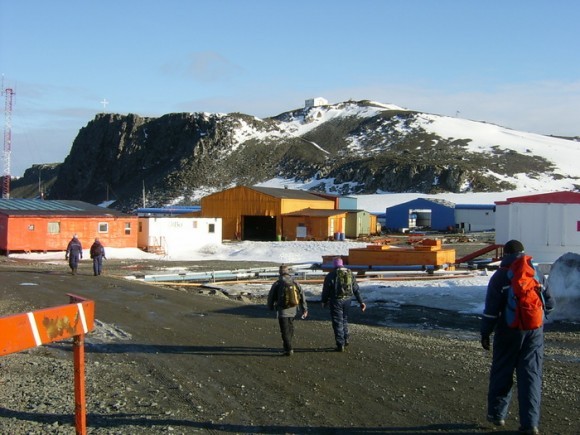 You can learn a lot from the members of the polar expeditions. They have a hard time of it, they risk their lives. For example, it seems as if in Russia more care is taken of technology than people and until recently in the Antarctic they basically used equipment that had been written off. Of course these machines break down and the polar mechanics have to take the engines to pieces and sort them out in temperatures of -50, without any sort of shelter, and then they have to repair them so they can get back to where they have to be. Many have lost their lives in the ice. There are 160 Russians buried there. I considered it my duty to pray for all these people, baptised, unbaptized, believers, non-believers…God knows!
You can learn a lot from the members of the polar expeditions. They have a hard time of it, they risk their lives. For example, it seems as if in Russia more care is taken of technology than people and until recently in the Antarctic they basically used equipment that had been written off. Of course these machines break down and the polar mechanics have to take the engines to pieces and sort them out in temperatures of -50, without any sort of shelter, and then they have to repair them so they can get back to where they have to be. Many have lost their lives in the ice. There are 160 Russians buried there. I considered it my duty to pray for all these people, baptised, unbaptized, believers, non-believers…God knows!
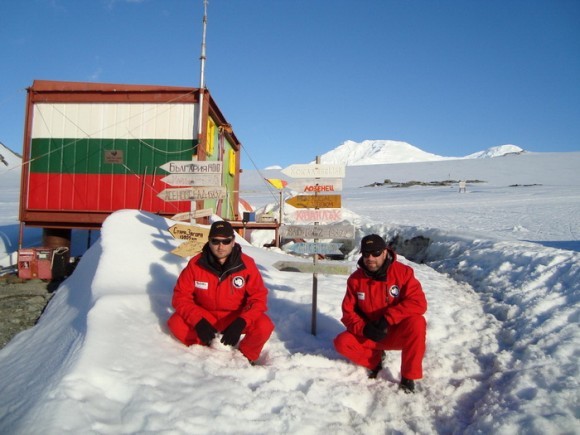
Unfortunately, during this stay there were virtually no Churched people at the station. There was only one person who more or less came to confession and took communion regularly, but then he was transferred to another station. True, two people were baptised and a couple of others would come with a need, but most of all they liked being alone in the church, they had no desire to listen to the Gospel, confess or listen to talks on spiritual topics. Perhaps, in part that was my fault because I did not manage to arouse interest in spiritual life among people, though of course I did try. But I hope that my attempts will bear fruit – the Lord will provide.
It’s cold. It’s dark. There’s not much sun. No green. How did you cope with depression?
Yes, this is one of the problems of polar stations, all around you reality is always the same black and white. There were many ways of fighting depression. For instance, going for walks and looking at the penguins. Anyone who is a bit down or tired takes a look at them and his mood is gone. I felt this, but not only me, others too, I noticed quite often that people would go off for a walk along the shore by the ocean and breathe the air. But you can’t go for walks in bad weather. As a rule, depression takes over when there is no sunshine. True, after the Liturgy on Sundays and feast-days it was often sunny.

Other days you could fight against negative thoughts through reading or watching a film. I read through the works of St Ignatius Brianchaninov and Dostoyevsky. And of course in such situations, if possible, you must not be alone. Anatoly was with me and sometimes he supported me and sometimes I supported him, so with God’s help we coped.
Apart from doing the services, what else did you do?
Officially, I and Anatoly were listed as technicians and repairmen and we had various jobs to do. Like everyone there we had different duties. For instance, repairs, as well as ongoing jobs like clearing up the baths, helping in the galley, washing floors…No exceptions are made in this respect, everyone is at the same level. One of the most complex jobs is clearing rust off the houses.
All the buildings at the station stand on concrete piles about 1-1.5 metres off the ground. This was done so that they would not get snow under. The houses are fixed with very sturdy bolts to special metal platforms and those in turn are fixed onto the piles. They have already been there for over forty years. The aluminium walls are fine, but the platforms, which are made of ferrous metal, have undergone significant corrosion.
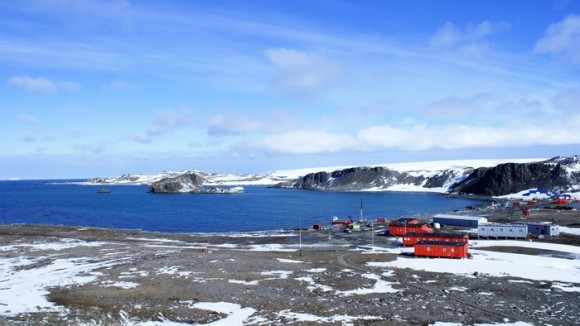 At the beginning, because we were not used to it, towards the evening our bodies would feel broken, our eyes would close all by themselves, as soon as we got near a bed or an armchair. The main reasons for this were acclimatization and the very pure ocean air. Our station and the church are on the shore of the continent and although you do not get really sharp frosts, there are strong winds and high humidity. In weather like that even temperatures of – 20 and -30 feel like – 60 and they recommend you stay inside.
At the beginning, because we were not used to it, towards the evening our bodies would feel broken, our eyes would close all by themselves, as soon as we got near a bed or an armchair. The main reasons for this were acclimatization and the very pure ocean air. Our station and the church are on the shore of the continent and although you do not get really sharp frosts, there are strong winds and high humidity. In weather like that even temperatures of – 20 and -30 feel like – 60 and they recommend you stay inside.
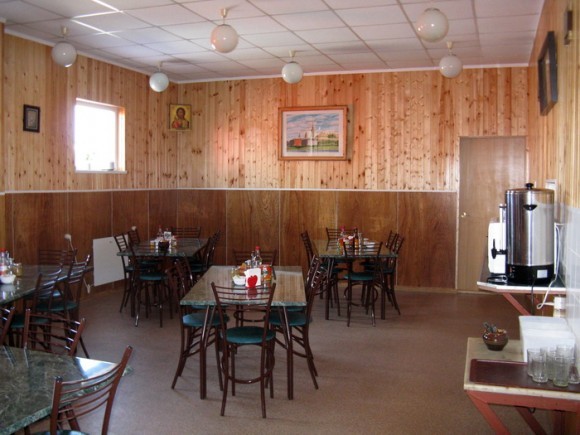 Sometimes we would have to work on our days off – we would clear up rubbish from the island which has piled up after fifty years of the station’s existence. At the beginning everything was just thrown out without any control and so piles of rubbish built up. This attitude to the environment has changed nowadays. By international agreement on the Antarctic it is forbidden to bring pets, earth, or seeds to the continent, so that no bacteria or viruses, alien to the natural environment can get there. It is deliberately kept clean because any non-indigenous matter attracts the sun’s rays and the ice begins to melt especially rapidly and so-called wellheads can form in the ice, meaning that an accident could happen when an aircraft lands.
Sometimes we would have to work on our days off – we would clear up rubbish from the island which has piled up after fifty years of the station’s existence. At the beginning everything was just thrown out without any control and so piles of rubbish built up. This attitude to the environment has changed nowadays. By international agreement on the Antarctic it is forbidden to bring pets, earth, or seeds to the continent, so that no bacteria or viruses, alien to the natural environment can get there. It is deliberately kept clean because any non-indigenous matter attracts the sun’s rays and the ice begins to melt especially rapidly and so-called wellheads can form in the ice, meaning that an accident could happen when an aircraft lands.
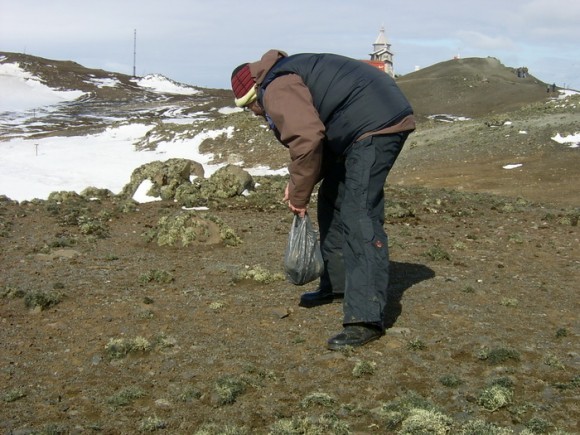 Did you ever feel unsafe?
Did you ever feel unsafe?
There was fear, but only from lack of understanding. When there was a strong wind, the house would begin to shake like a moving tram and the first few days I really did not feel safe. I would start to pray very hard that the house would not be blown away. While I was there, there were no accidents on our station, but they had a fire at the Brazilian station. And because the builders had not fixed the water tank properly, the wind tore it away and blew it towards the houses. But by the mercy of God it was blown between the buildings and straight into the ocean. There was another time when instead of winter diesel they left summer diesel and it froze. You can imagine what it means to be without heat in the Antarctic.
There are people who want to be at the North or South Poles. Why?
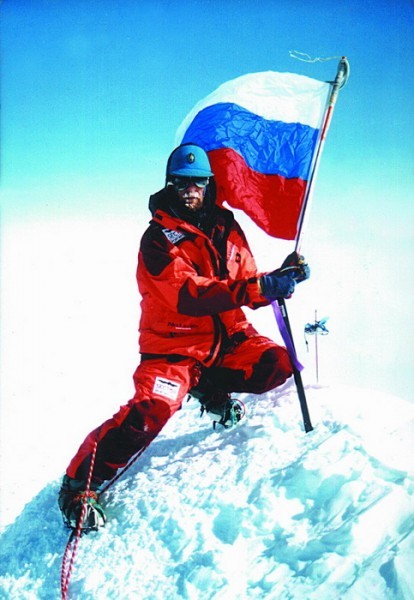 I thought a lot about that and understood that it is not just a question of surpassing ourselves (we can surpass ourselves in other circumstances too), it’s a subconscious desire to find our bearings, our direction. Just as the globe turns on its axis, so people’s hearts beat because of some main aim. This aim is different for each person. But if people arrange their lives in such a way that everything turns around God, then life will be joyful.
I thought a lot about that and understood that it is not just a question of surpassing ourselves (we can surpass ourselves in other circumstances too), it’s a subconscious desire to find our bearings, our direction. Just as the globe turns on its axis, so people’s hearts beat because of some main aim. This aim is different for each person. But if people arrange their lives in such a way that everything turns around God, then life will be joyful.
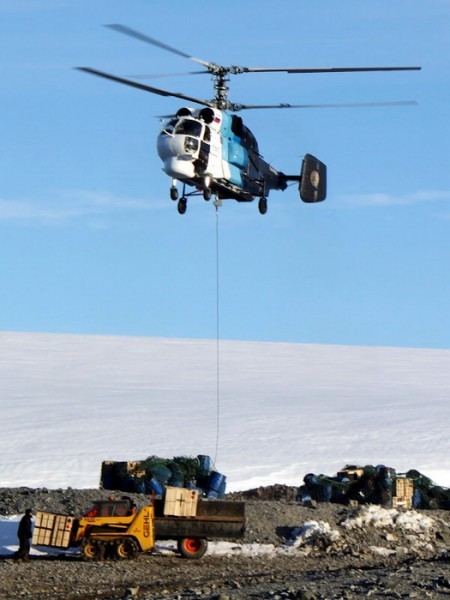 The Lord made the world in such a way that the invisible and immaterial axis of the world has a huge significance. All visible and material things turn around it, the oceans, the continents, cities and villages with people and their belongings. Everything is subordinated to this universal law, given to the Earth by God.
The Lord made the world in such a way that the invisible and immaterial axis of the world has a huge significance. All visible and material things turn around it, the oceans, the continents, cities and villages with people and their belongings. Everything is subordinated to this universal law, given to the Earth by God.
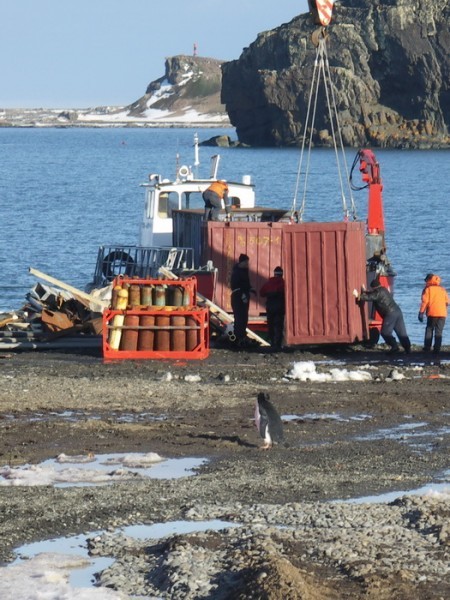 If the axis of the planet, around which everything turns, completely changed direction, then there would be a worldwide catastrophe! This arrangement of the visible world only serves to remind us of the arrangement of the invisible, spiritual world. Someone said that Jesus Christ is the axis of world history. And this ‘world axis’ goes through the heart of all the citizens of the Earth. And I think that each of us has felt within us this invisible spiritual bearing which is called the Holy Spirit.
If the axis of the planet, around which everything turns, completely changed direction, then there would be a worldwide catastrophe! This arrangement of the visible world only serves to remind us of the arrangement of the invisible, spiritual world. Someone said that Jesus Christ is the axis of world history. And this ‘world axis’ goes through the heart of all the citizens of the Earth. And I think that each of us has felt within us this invisible spiritual bearing which is called the Holy Spirit.
What else did the Antarctic teach you?
My obedience in the Monastery is to organize the Sunday school. Before I left, I felt as if I were at my last gasp. Various questions constantly worried me: What next? What should I teach? What shall I talk about? When I went off to the Antarctic, somewhere in the bottom of my soul I had the thought that this voyage would give me answers to the questions that worried me. During my winter stay I realized especially clearly how weak I am and how much I still have to work on myself.
I understood that in order to go to the Antarctic and work there effectively, you have to be ready to accept that you will not get your hand kissed and or have your blessing asked very often, but you will, as it were, wash the feet of those who are alongside you. For those at the polar station matters like who you are, how you are dressed and the words you say are not important, it is what you do that is important.
And I also felt there that I and the scientists were people with a very different spiritual make-up and aims. Although they are very good people, unfortunately, we did not have the same spiritual direction, as I have with the other monks in the monastery. Now I am back in the monastery, I am especially glad whenever I meet any real believer, especially the monks.
Do you have any desire to repeat your winter stay in the white wilderness of the Antarctic?
There are those who have been there and cannot live without the Antarctic and really do speak of love for ‘the white wilderness’. In April or May they return to the mainland and then in October or November, if invited, they go back. I already told someone jokingly that I would go back again if the head of the station agreed to get baptized (he was unbaptized). But seriously, I think that if there were some likeminded believers in such conditions, then we could have a sort of skete, a little monastery, a ‘scientific’ dependency of one of the Orthodox monasteries. I would be only too happy to serve in such a ‘monastery’. But it is all God’s will.
Interviewer: Dimitry Artyukh
Translated from the Russian












